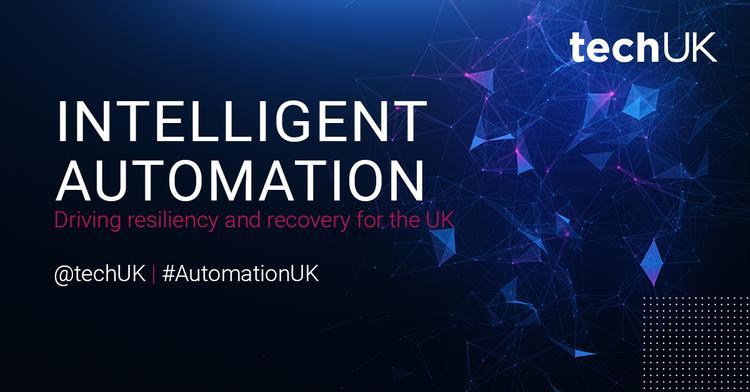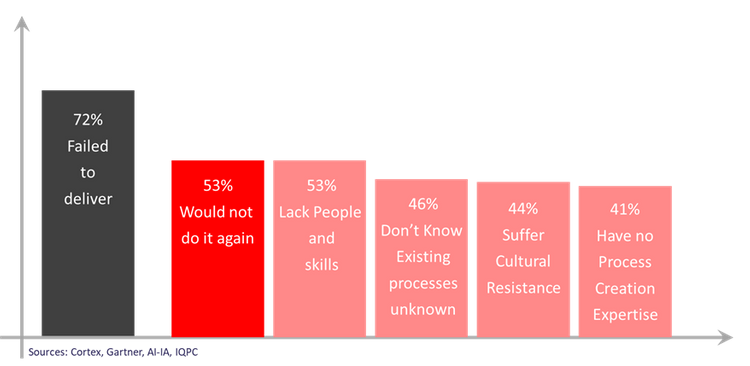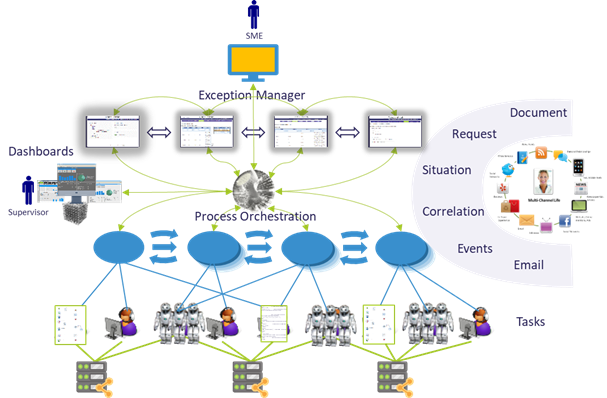It is critical to start by understanding some basics about automation

Automation is not as easy as it at first looks. Executive boards across industries have recognised Automation as a panacea for many ails of their modern economic situation from competitive advantage to cost reduction.
The world of Automation of business operations has fundamentally changed in recent years. The functional automation embedded in business systems that help us match PO’s and pay Invoices is well understood, it is entirely the world of machines and is easily extended by simple configure once tools. Screens and keyboards at desks are the interfaces between the processes and system tasks. Automation in the new world of work is a collaboration of man and machine in executing the processes and managing the services delivered to clients.
Too often the principles of functional automation are used to try and be successful in process automation. Unfortunately, our research shows that 72% of these initiatives fail to deliver business benefits. Task automation tooling such as RPA combines these familiar functional techniques with task automation and ends up a patch and extends the current systems rather than creating a path to digital transformation. Forrester’s research shows that only 1.8% of RPA (Desktop Task Automation) achieves scale, and most deliver insignificant or negative impact.

Terminology
One of the major issues is terminology. Being able to communicate in specifics when dealing with moving effort from people to machines is critical to success. For example, what is Automation, and why do we define Automation and automation differently. One is the Proper Noun; the conceptual big picture thing recognised by the boardroom, the other is the name of a type of real activity on the ground. There is only one type of Automation, but there are many types of automation. Data, functional, task, process, decision, etc… This highlights a key aspect of success. The terminology must be agreed. Words like Workflow, Process, Orchestration, and Automation are flung around by vendor marketing departments like flags in a tornado. Often designed to give grander aspirations to lesser achievements, destroyed in meaning by the very thing that seeks to give them identity. This is why, at Cortex, we freely publish a terminology guide that defines terms to give our industry a communication platform for achieving automation success.
You can download the guide here: https://www.cortex-ia.com/wp-content/uploads/Cortex-Terminology-Guide.pdf
Strategies
One interesting data point from our research is that 84% of projects are technically successful. This points to the wrong strategies, rather than the wrong technology or method. The majority of new projects look to identify the technology to use before fully scoping the process, and as we can see from the data most projects do not understand the process so inevitably choose the wrong technology or the wrong scope.
We always encourage our clients to start with the vision; What does your operation look like when you have automated? Then work backward to a roadmap to that vision, build an operational plan and a communication plan. This will enable the vision achieved in getting automated, is realised in staying automated.
It is nigh on impossible to bring back redeployed headcount as an initially successful automation rapidly decays over time due to the wrong technology or poorly understood operations. This leads to self-destructive extended operational change windows, and degrading quality of service.
Man and Machine
It is critical to start by understanding some basics about automation. What can and should be handed to a machine-centric operation and what should not. Embedded in this is the realisation that man and machine will always co-exist at some point for escalation, intervention, manual action, or otherwise. So a critical component to technology selection is to understand how man and machine interact in the operational environment. Suddenly having failed processes jump out of a black box operation at you is not only disconcerting, but it is onerous and slow to manage.
Methods
One of the biggest mistakes organisations have been indoctrinated to make is to review and optimise processes before automation. This is only a good idea when processes are functionally broken, not when the only issues are Accuracy, Quality, Velocity, Capacity, Scalability, Complexity, Agility, or Cost. The problem with optimising processes is that it comes from a workflow perspective which is an imprecise and human-centric perspective over all the permutations of processes involved. This is the opposite of the specific processes the machines need. Workflows are often defined in an idealistic way, and deal with the happy path. Real processes have exceptions, and workarounds, and non-ideal activities. For machines to operate accurately they need these “Emergent” processes, not the “Authoritative” approach that re-engineering or optimisation provides.
Considering all machines need human assistance at some point, the interaction must be seamless which requires planning but also a relationship based upon trust and confidence. Shoving an automation solution on a team, will likely not deliver the outcomes desired due to cultural resistance.
The easiest way to think about processes is to follow the SADA model. The model categorises activities into 4 sectors:
Sensing: is understanding what something is. Whether it is an incoming invoice or a high-speed event on a telecoms network. This can be extended into the world of Cognitive toolings such as computer imaging, and NLP. This should result in a Message that contains not just the sensed thing, but structured information about it.
Analysing: is putting the Sensed thing into context. Is the invoice from a new supplier, is the network even related to other events, is it valid, is it relevant? Analysis should result in a situation that is actionable (or not as the case may be).
Deciding: The stage is mostly ignored by simple tooling, but critical to enterprise-scale processes. The governance, the policies, the rules both natural and mandated. Does this situation require authorisation, is it within the parameters of reasonable responses? Do we even know how to deal with this? who should authorise this? or what outcome we expect?
Action: This stage is the simple step of sequencing the actions required. This is usually where most current technology activity is applied.. tools such as RPA, Scripts, Macros, and Code often already exist to assist with automated tasks.
At the core of which is the decision engine which drives the orchestration of processes and tasks to achieve outcomes. SADA helps map processes of all complexities onto a model which aids with the mapping of workflows, identification of assistive technologies, and the integrations required. Classic automation failures often come from attempts to introduce “AI” into task automation believing that this incremental step in making tasks intelligent will enable end-to-end processes to be automated. This type of intelligent automation is self-limiting.
Take the journey in steps, start simple and start with what you know. Change is good but too much change is chaos. Incremental steps are good but in the context of a plan and a Roadmap to a vision. First, build Trust between man and machine and then the confidence to evolve your operations together otherwise you will find yourself in reverse gear very quickly.

Summary
Getting automated is easy, staying automated requires a transformational approach. Transformation at scale is hard, risky, and the cost of change is often too high so an evolutionary approach is required. At Cortex, even though we are a software company, we focus on the Strategies to Automate, the Methods to automate, and the Technology to evolve, and this is why we maintain a 96% success rate in delivering business outcomes. It is also why most organisations fail to scale with their pre-chosen automation technology, more often than not RPA.
Incrementally Intelligent Automation without a Strategy and Method will often deliver no value. Digital Evolution will get you to the destination. Digital Transformation will likely have unintended consequences.
You can read all insights from techUK's Intelligent Automation Week here

Laura Foster
Laura is techUK’s Associate Director for Technology and Innovation.








